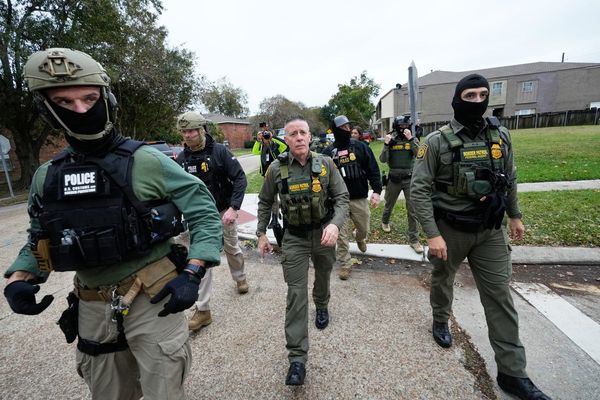
Look carefully through the trees, and it is just possible to catch sight of Onagawa nuclear power plant from its visitors’ centre, perched on a hill surrounded by thick woods.
The plant’s supporters may have had its remote location, on a rugged peninsula in Japan’s north-east, in mind when they campaigned to bring nuclear power – and the promise of subsidies – to the town more than 40 years ago.
Despite its seclusion, the plant is now in the political spotlight, as Japan prepares to again put its faith in nuclear power, more than a decade after the triple meltdown at Fukushima Daiichi.
In a sweeping change to the country’s energy policy, the prime minister, Fumio Kishida, has announced plans to build next-generation reactors and restart those left idle after the 2011 triple meltdown, in an attempt to end Japan’s dependence on imported fossil fuels and help meet its net zero target by 2050.
Kishida’s “green transformation”, which could include extending the lifespan of existing reactors beyond the current maximum of 60 years, underlines Japan’s struggle to secure an affordable energy supply as a result of the war in Ukraine and a power crunch that has triggered warnings of potential blackouts in Tokyo during this summer’s heatwave.

Most of Japan’s nuclear power plants have remained offline since the Fukushima meltdown, and previous governments indicated they would not build new reactors or replace ageing ones, fearing a backlash from a shaken and sceptical public.
Japan plans for nuclear to account for 20-22% of its electricity supply in 2030, compared with about a third before Fukushima. In 2020 the figure was less than 5%. Just 10 nuclear reactors among more than 30 have been restarted since the post-Fukushima introduction of stricter safety standards.
If Kishida gets his way though, seven additional reactors will be restarted after next summer, including the No. 2 unit at Onagawa, which sustained structural damage from the 2011 earthquake and tsunami but escaped a catastrophic meltdown despite being the closest atomic plant to the quake’s epicentre.
‘A threat to the safety of local people’
The restart has been approved by Japan’s nuclear watchdog and given “local consent” by Yoshihiro Murai, the governor of Miyagi – the prefecture where Onagawa is located.
But many residents argue that contingency plans for potential accidents would put lives at risk.
“The evacuation plans won’t work … they are a threat to the safety of local people,” says Masami Hino, one of 17 residents living within 30km of the plant who last year launched a legal action to block the restart, now scheduled for early 2024.
In the event of a serious accident, 1,000 residents living within 5km of the plant would leave immediately, while 190,000 people within a 30km radius would evacuate in stages, according to the official blueprint.
“There will be huge traffic jams, and we won’t be able to escape,” says Hino, who cited one expert simulation – dismissed by local authorities – showing that it could take up to five days for everyone to make it to safety.
“If there is an accident it is ridiculous to think that people will leave in an orderly way,” he said. “They will just get out as quickly as they can and then get stuck for days without food, water or access to toilets.”
Critics say an evacuation in the wake of an accident would clog the area’s narrow, winding roads, leaving people at risk of exposure to radiation. Most would leave in private cars, but others would have to board buses. The plant’s operator, Tohoku Electric Power, and local authorities would provide almost 1,000 staff to screen people for radiation exposure before directing them to temporary shelters.
“How can Tohoku Electric and the prefecture guarantee that an evacuation would go smoothly after something like a major earthquake? It’s impossible,” says Mikiko Abe, an independent member of the Onagawa town assembly who has spent 40 years campaigning for the plant’s closure.
“Instead of planning for an evacuation, wouldn’t it be better to live safely in a place where there’s no need to even think about fleeing our homes?”

Kishida’s response to energy insecurity and the climate crisis has won the backing of Fatih Birol, the head of the International Energy Agency (IEA), who said restarting more nuclear plants in Japan – one of the world’s biggest consumers of liquefied natural gas (LNG) – would free up more LNG and help ease Europe’s energy supply fears during the winter.
Domestic opposition to a bigger role for nuclear in the energy mix appears to be weakening. A poll by the Nikkei business paper in June found that 53% of respondents agreed with putting reactors back into service if their safety could be assured – the first time that support for restarts had exceeded opposition since the 2011 triple disaster.
While pro-nuclear members of the Miyagi prefectural assembly have helped resist calls for a referendum, a poll in April by the local Kahoku Shinpo newspaper found that 56% of residents were “strongly” or “somewhat” opposed the restart.
“All of Japan’s nuclear power plants are on the coast … and this is a country that has earthquakes, tsunamis and volcanoes,” says Tsuyoshi Suda, a member of local anti-nuclear group Kaze no Kai, as he looked at the plant – complete with a newly built 29-metre high seawall – from a nearby beach.
“For Japan to keep putting its faith in nuclear power plants is like a form of self-destruction.”







